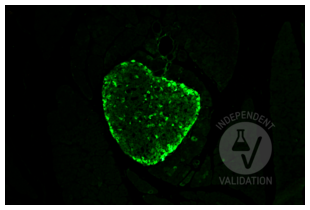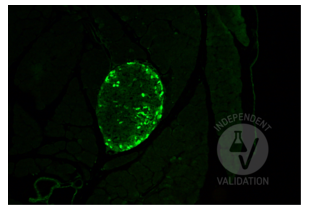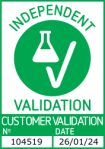Glucagon 抗体
-
- 抗原 See all Glucagon (GCG) 抗体
- Glucagon (GCG)
-
适用
- 人
-
宿主
- 兔
-
克隆类型
- 多克隆
-
标记
- This Glucagon antibody is un-conjugated
-
应用范围
- ELISA, Western Blotting (WB), Immunohistochemistry (IHC), Immunofluorescence (IF), Fluorescence Microscopy (FM)
- Supplier Product No.
- 600-401-mv9
- Supplier
- Rockland
- 原理
- Glucagon Antibody
- 交叉反应 (详细)
- This affinity purified antibody is directed against human Glucagon.
- 产品特性
- Synonyms: Rabbit Anti-Glucagon, Pro-glucagon, Glicentin, Oxyntomodulin, OXM, OXY, Glucagon
- 纯化方法
- This product was affinity purified from monospecific antiserum by immunoaffinity purification.
- 过滤
- Sterile filtered
- 免疫原
-
Immunogen: Glucagon antibody was prepared from whole rabbit serum produced by repeated immunizations with a synthetic peptide corresponding to an internal portion of human Glucagon.
Immunogen Type: Conjugated Peptide
- 亚型
- IgG
-
-
- 应用备注
-
Immunohistochemistry Dilution: 1:100
Application Note: Anti-Glucagon is tested in ELISA, IF, IHC, and Western Blot. Expect a band approximately ~20.9 kDa corresponding to the appropriate cell lysate or extract. Specific conditions for reactivity should be optimized by the end user.
Western Blot Dilution: User Optimized
ELISA Dilution: 1:24,800-1:44,800
IF Microscopy Dilution: 5-15 μg/mL
- 限制
- 仅限研究用
-
- by
- Prof. Merighi, Laboratory of Neurobiology, Department of Veterinary Sciences, University of Turin
- No.
- #104519
- 日期
- 2024.01.26
- 抗原
- Glucagon
- Lot Number
- 49549
- Method validated
- Immunohistochemistry
- Positive Control
Adult (> 2 months) CD1 mouse pancreas fixed in 4% paraformaldehyde.
- Negative Control
One control slice for each experimental procedure processed omitting the primary antibody; overnight incubation in diluent solution only.
- Notes
Passed. The Glucagon antibody ABIN7448121 works in IHC-P at 1:100 concentrations with microwave antigen retrieval treated sections.
- Primary Antibody
- ABIN7448121
- Secondary Antibody
- anti-rabbit secondary antibody Alexa Fluor 488 (Thermo Fisher Scientific, A11034, lot # XJ357262)
- Full Protocol
- Perfuse mice with paraformaldehyde 4% in 0.1 M phosphate buffer pH 7.4 and post-fix of samples in the same fixative for an additional 2 h at RT.
- Wash, dehydrate, and embed samples in paraffin wax.
- Wash several times with 0.01 M PBS.
- Cut brain with a microtome into 6 µm sections and mount on glass slides.
- After paraffin removal processed sections for microwave antigen retrieval for 10 minutes (95-100° C) in 10 mM sodium citrate buffer (pH 6.0). After 20 minutes of spontaneous cooling, wash sections (distilled water, 2 times for 5 minutes each; followed by PBS for 5 minutes).
- Incubate sections for 1 h at RT in a humid chamber in PBS containing 1% ovalbumin (Sigma, A5378) and 0.3% Triton-X-100 (BioRad, 161-0407, lot 00583) to block non-specific binding sites.
- Incubate sections with primary rabbit anti- Glucagon (antibodies-online, ABIN7448121, lot 49549) diluted 1:50 and 1:100, in PBS-BSA-PLL ON at RT in a humid chamber.
- Wash sections 3x 5 min with 0.01 M PBS.
- Incubate sections with anti-rabbit secondary antibody Alexa Fluor 488 (Thermo Fisher Scientific, A11034, lot # XJ357262), 1:500, in 0.1M PBS, 1 hour at room temperature.
- Wash sections 3x 5 min in 0.01 M PBS.
- Mount specimens in Fluoroshield (Sigma, F6182, lot MKCB0153V).
- Acquire images Leica DM 6000B fluorescence microscope equipped with a digital camera at 40x magnification.
- Experimental Notes
生效 #104519 (Immunohistochemistry)![成功验证 '独立验证'标志]()
![成功验证 '独立验证'标志]() Validation ImagesFull Methods
Validation ImagesFull Methods -
- 状态
- Liquid
- 浓度
- 1.18 mg/mL
- 缓冲液
-
Buffer: 0.02 M Potassium Phosphate, 0.15 M Sodium Chloride, pH 7.2
Stabilizer: None
Preservative: 0.01 % (w/v) Sodium Azide - 储存液
- Sodium azide
- 注意事项
- This product contains Sodium azide: a POISONOUS AND HAZARDOUS SUBSTANCE which should be handled by trained staff only.
- 储存条件
- 4 °C,-20 °C
- 储存方法
- Store vial at -20° C prior to opening. Aliquot contents and freeze at -20° C or below for extended storage. Avoid cycles of freezing and thawing. Centrifuge product if not completely clear after standing at room temperature. This product is stable for several weeks at 4° C as an undiluted liquid. Dilute only prior to immediate use.
- 有效期
- 12 months
-
- 抗原
- Glucagon (GCG)
- 别名
- GCG (GCG 产品)
- 背景
- Background: Glucagon is a member of a multigene family that includes secretin. Glucagon is a 29-amino acid pancreatic hormone that counteracts the glucose-lowering action of insulin by stimulating glycogenolysis and gluconeogenesis. The human glucagon gene is approximately 9.4 kb long, contains 6 exons and 5 introns, and assigned to 2q36-2q37. This antibody is suitable for researchers interested in metabolic diseases, like diabetes, cell proliferation, differentiation, apoptosis, GCPR signaling, and calcium signaling research.
- 基因ID
- 2641
- NCBI登录号
- NP_002045
- UniProt
- P01275
- 途径
- Positive Regulation of Peptide Hormone Secretion, Peptide Hormone Metabolism, cAMP Metabolic Process, Regulation of Carbohydrate Metabolic Process, Feeding Behaviour, Negative Regulation of intrinsic apoptotic Signaling
-



 (1 validation)
(1 validation)




